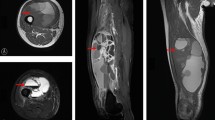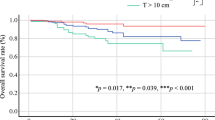Abstract
Background
Myxofibrosarcomas (MFS) are a historically heterogeneous group of tumors that exhibit a propensity for local recurrence. The objectives of this study were to analyze the prognostic factors and outcomes of patients with MFS treated at a single institution.
Methods
We retrospectively reviewed the records of 69 consecutive patients with pathologically confirmed MFS of the extremities or superficial trunk who underwent surgery from August 1995 to November 2010. Clinicopathologic features, treatments, and patient outcomes were reviewed.
Results
Sixty-nine patients were identified, of whom 38 were men (55 %). The median age was 62 years. Sixty-four patients (93 %) presented with primary tumors, and 5 patients (7 %) presented with locally recurrent tumors. Median tumor size was 6.0 cm, and 44 patients (64 %) had grade 3 tumors (FNCLCC [Fédération Nationale des Centres de Lutte Contre le Cancer] classification). Margins were microscopically positive in 14 patients (20 %) and negative in 55 patients (80 %), including close margins (<1 mm) in 14 patients (20 %). Fifty-three patients (77 %) received radiotherapy. At a median follow-up of 41 months, there were 11 local (16 %) and 11 distant (16 %) recurrences. The local and distant 5-year recurrence-free survival rates were 72 % and 82 %, and the 5-year overall survival was 61 %. Increased age (scaled by 0.1; hazard ratio [HR] 1.80, P = 0.002) and tumor size (HR 1.12, P = 0.004) were negatively correlated with overall survival. Positive/close (<1 mm) margin status (HR 4.34, P = 0.030) predicted worsened local recurrence-free survival.
Conclusions
MFS exhibit a propensity for local recurrence, which is predicted by resection with positive or close margins. Aggressive surgery combined with radiotherapy may contribute to more effective local control.

Similar content being viewed by others
References
World Health Organization classification of tumours.1. Mentzel TMD, Calonje EMD, Wadden CFIBMS, et al. Myxofibrosarcoma: clinicopathologic analysis of 75 cases with emphasis on the low-grade variant. Am J Surg Pathol. 1996;17:595–600.
Merck C, Angervall L, Kindblom L, Oden A. Myxofibrosarcoma. A malignant soft tissue tumor of fibroblastic–histiocytic origin. A clinicopathologic and prognostic study of 110 cases using multivariate analysis. Acta Pathol Microbiol Immunol Scand. 1983;282(Suppl.):1–40.
Fletcher CD, Gustafson P, Rydholm A, Willen H, Akerman M. Clinicopathologic re-evaluation of 100 malignant fibrous histiocytomas: prognostic relevance of subclassification. J Clin Oncol. 2001;19:3045–50.
Angervall L, Kindblom LG, Merck C. Myxofibrosarcoma: a study of 30 cases. Acta Pathol Microbiol Scand. 1977;85A:127–40.
Weiss SW, Enzinger FM. Myxoid variant of malignant fibrous histiocytoma. Cancer. 1977:1685.
Fletcher CDM, Unni KK, Mertens F. Pathology and genetics of tumors of soft tissue and bone. In: World Health Organization classification of tumours. Lyon: IARC Press; 2002. p. 102–3.
Gronchi A, Lo Vullo S, Colombo C, et al. Extremity soft tissue sarcoma in a series of patients treated at a single institution: local control directly impacts survival. Ann Surg. 2010;251:506–11.
Waters B, Panicek DM, Lefkowitz RA, et al. Low-grade myxofibrosarcoma: CT and MRI patterns in recurrent disease. Am J Roentgenol. 2007;188:W193–8.
Huang HY, Lal P, Qin J, Brennan MF, Antonescu CR. Low-grade myxofibrosarcoma: a clinicopathologic analysis of 49 cases treated at a single institution with simultaneous assessment of the efficacy of 3-tier and 4-tier grading systems. Hum Pathol. 2004;35:612–21.
Manoso MW, Pratt J, Healey JH, Boland PJ, Athanasian EA. Infiltrative MRI pattern and incomplete initial surgery compromise local control of myxofibrosarcoma. Clin Orthop. 2006;450:89–94.
Haglund KE, Raut CP, Nascimento AF, Wang Q, George S, Baldini EH. Recurrence patterns and survival for patients with intermediate and high grade myxofibrosarcoma. Int J Radiat Oncol Biol Phys. 2010;82:361–7.
Sanfilippo R, Miceli R, Grosso F, et al. Myxofibrosarcoma: prognostic factors and survival in a series of patients treated at a single institution. Ann Surg Oncol. 2011;18:720–5.
Lin CN, Chou SC, Li CF, et al. Prognostic factors of myxofibrosarcomas: implications of margin status, tumor necrosis, and mitotic rate on survival. J Surg Oncol. 2006;93:294–303.
Mentzel TMD, Calonje EMD, Wadden CFIBMS, et al. Myxofibrosarcoma: clinicopathologic analysis of 75 cases with emphasis on the low-grade variant. Am J Surg Pathol. 1996;17:595–600.
Fukunaga N, Fukunaga M. Low grade myxofibrosarcoma: progression in recurrence. Pathol Int. 1997;47:161–5.
Zagars GK, Ballo MT, Pisters PW, et al. Prognostic factors for patients with localized soft tissue sarcoma treated with conservative surgery and radiation therapy: an analysis of 1,225 patients. Cancer. 2003;97:2530–43.
Kaya M, Wada T, Nagoya S, et al. MRI and histological evaluation of the infiltrative growth pattern of myxofibrosarcoma. Skeletal Radiol. 2008;37:1085–90.
Hafner J, Schütz K, Morgenthaler W, Steiger E, Meyer V, Burg G. Micrographic surgery (“slow Mohs”) in cutaneous sarcomas. Dermatology. 1999;198:37–43.
Rosenberg SA, Tepper J, Glatstein E, et al. The treatment of soft tissue sarcomas of the extremities: prospective randomized evaluations of limb-sparing surgery plus radiation therapy compared with amputation and the role of adjuvant chemotherapy. Cancer. 1982;196:305–15.
Pisters PW, Harrison LB, Leung DH, et al. Long-term results of a prospective randomized trial of adjuvant brachytherapy in soft tissue sarcoma. J Clin Oncol. 1996;14:859–68.
Yang JC, Chang AE, Baker AR, et al. Randomized prospective study of the benefit of adjuvant radiation therapy in the treatment of soft tissue sarcomas of the extremity. J Clin Oncol. 1998;16:197–203.
Acknowledgment
Supported in part by Biostatistics Core of Dana-Farber/Harvard Cancer Center, supported by NCI Cancer Center Support Grant NIH 5 P30 CA06516.
Author information
Authors and Affiliations
Corresponding authors
Additional information
The last two authors contributed equally to this work, and both should be considered senior author.
Rights and permissions
About this article
Cite this article
Look Hong, N.J., Hornicek, F.J., Raskin, K.A. et al. Prognostic Factors and Outcomes of Patients with Myxofibrosarcoma. Ann Surg Oncol 20, 80–86 (2013). https://doi.org/10.1245/s10434-012-2572-3
Received:
Published:
Issue Date:
DOI: https://doi.org/10.1245/s10434-012-2572-3




